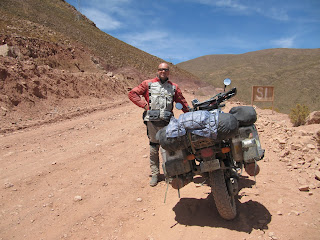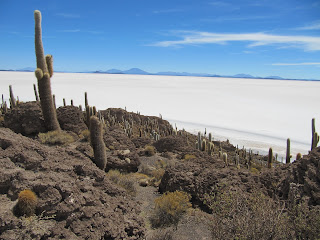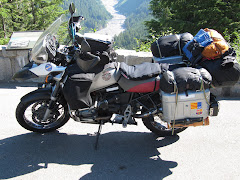We finally left Peru after 3 weeks but not before encoutering another crooked cop at the border crossing. Once we had all the paperwork cleared to continue our crossing over to the Bolivian side of the border there was a chain across the road blocking all access, a chain wich is opened by the police once you are cleared to go. When we explained to the policeman guarding the chain that we had been cleared by immigration and customs he made Eva a sign to approach him quietly. He then asked for a ‘donation’ as the police were building an extension to the back of the cop shop, and they were asking for the co-operation of the people passing by!! (Another one filling his retirement fund!!!). But not with our money this time. So off we went to Bolivia. The drive from Copacabana, very close to the border, up to the Lake Titicaca crossing was stunning, a mountain drive wich eventually brough us up above a hill over Lake Titicaca, with views of the lake at either side of the road and snowed cap peaks on the horizon, really beautiful! The road started to descent down on to a small coast town where small ferries take people and vehicles across the lake, more like rafts than ferries as you will see on the video below.
Desprès de quasi 3 setmanes al Perú sortim del país però no sense trobar-nos de un altre cop amb un altre policia corrupte. Un cop ja tenim tots els papers enllestits a la frontera de la part del Perú ens trobem amb una cadena que ens impedeix el pas, una cadena que normalment la policia obre en quan un te tots els papers enllestits de immigració i de la duana. De sobte el policia de torn em crida i em fa un senyal ben discret per que m’apropi, un cop soc al seu costat em fot un rotllo i em demana que li doni la voluntat ja que estan construint una ampliació de la part del darrere de la comissaria i que demanen els que passen per una ‘donació’, que viu el paio!! (un altre poli que eta estalviant pel seu fons de jubilació!!). Però de la nostra butxaca ni un duro aquest cop! Així que vam tirar cap a Bolívia. El recorregut des de Copacabana, molt a prop de la frontera, fins a creuar el Llac Titicaca va ser molt escènic, fins a portar-nos fins dalt d’un cim on teníem vistes del llac als dos costats de la carretera i muntanyes enormes plenes de neu a l’horitzó, molt bonic! Un cop la carretera baixa cap avall porta fins un poblet on uns fèrries passen viatgers i vehicles a l’altre banda del llac Titicaca, be, mes que fèrries semblen mes com balses com podreu veure en el següent vídeo.
Then we headed for La Paz, the highest capital of the world, 3660m above sea level, the most breathtaking location, you approach the city by the altiplano and then all of a sudden there is a huge bowl with the city spread out inside in it, and to get into the city you have to use near vertical streets with hairpin bends every couple of hundred meters, and with the worst drivers on the planet! We decided to come here as we had to pick up a set of new tires suitable for the rougher roads that were ahead. Thanks again to Jorge Neira, from Iquique (Chile) who organized all that for us, as well as giving us routes and details of what was to come.
Desprès de la travessa vam anar tirant cap a La Paz, la capital a mes alçada del món, 3660m sobre el nivell del mar, situada en un lloc inesperat, en quan t’apropes a la ciutat per l’altiplano de sobte et trobes amb un gran sotrac en forma de bol i allà sota trobes la ciutat, i per baixar-hi has de pasar per carrers amb pendents quasi verticals i corbes de sifó cada pocs metres, i amb els pitjors conductors del planeta! Vam decidir de venir-hi per que havíem de recollir unes rodes per la moto mes adequades per les carreteres que havien de venir en els següents dies. Donem les gràcies a Jorge Neira, de Iquique (Xile) que ho va organitzar lo dels neumàtics i ens va donar idees per les rutes a seguir en el nostre viatge.
Desprès de la travessa vam anar tirant cap a La Paz, la capital a mes alçada del món, 3660m sobre el nivell del mar, situada en un lloc inesperat, en quan t’apropes a la ciutat per l’altiplano de sobte et trobes amb un gran sotrac en forma de bol i allà sota trobes la ciutat, i per baixar-hi has de pasar per carrers amb pendents quasi verticals i corbes de sifó cada pocs metres, i amb els pitjors conductors del planeta! Vam decidir de venir-hi per que havíem de recollir unes rodes per la moto mes adequades per les carreteres que havien de venir en els següents dies. Donem les gràcies a Jorge Neira, de Iquique (Xile) que ho va organitzar lo dels neumàtics i ens va donar idees per les rutes a seguir en el nostre viatge.
 |
| A tight squezee! Una mca apretadets! |
After 2 nights we changed the tires and left for Potosi, the highest city in the world (as oposed to capital city) 4090m above sea level. Needless to say that at that altitude with the lack of oxigen and the high pollution took a toll on us, so we were happy to be leaving the city at last. From there we headed to Uyuni, the base town to visit the Salar de Uyuni, the biggest salt flat in the world (12000km2). This is where the really rough road started, wich turned out to be quite difficult with the 2 of us on the bike plus all the luggage. After a tough day we eventually got to Uyuni, booked into a hotel and met Richard, a swiss guy with Bolivian origins who burst the back shock of his 1200GSA coming down the road that we initially decided to take to come down to Uyuni, so we did quite well all things considered! We wish him the best and hope he got it sorted and he's back on the road. After a quick reconnaissance trip by Trevor out the road that we suposed to take the following morning, we decided that Eva and the luggage were safer to travel on a jeep as far as the salar and Trevor would drive the bike on his own. After a few hours we arranged to meet again at the island of Inkawasi, situated in the middle of the salar, a peculiar rock and coral formation covered with giant cactuses, and from wich you could climb and get stunning views of the salar area.
Desprès de pasar-hi 2 nits vam canviar les rodes i vam tirar cap a Potosí, la ciutat a mes alçada del món, 4090m sobre el nivell del mar. No cal a dir que tanta alçada, amb la falta d’oxigen i l’alt nivell de pol·lució ens va deixar molt tocats, fins el punt de que vam ser molt contents de marxar d’aquell lloc d’una vegada. Des d’allà vam anar cap a Uyuni, que es el poble ‘base’ pels que volen visitar el Salar de Uyuni, les salines mes grans del mon (12000Km2). Aquí es on la carretera es va tornar ben difícil, especialment amb tots dos i tot l’equipatge a sobre. Desprès d’un dia dur de viatge vam arribar a Uyuni, vam buscar un allotjament i vam conèixer a Richard, un suís amb orígens Bolivians al que se li acabava de trencar l’amortiguador de la seva BMW 1200GSA a la carretera per la que inicialment pensàvem agafar per arribar fins allà però vm canviar d’idea a l’últim moment, així que malgrat les circumstàncies a nosaltres no ens va anar tant malament! Desprès de que el Trevor anés a fer una ullada de reconeixement de la ruta que havíem d’agafar a l’endemà vam decidir de que la Eva i l’equipatge anessin fins el Salar amb un jeep i el Trevor portés la moto sol fins allà. Desprès d’unes hores ens vam retrobar a la illa de Inkawasi, situada al mig del Salar, una curiosa formació de roca i corall ple de cactus gegants, des de on es podien veure vistes magnifiques de la zona del Salar.
After a morning and afternoon of playing in the salt we both headed on the bike towards the village of Chuvica, at the south edge of the salar. Driving in the salar is a surreal experience: you are driving at 100Km/hour but is like you are going nowhere as everything is white and flat and there’s nothing for miles and miles. We both really enjoyed it and it was a hard place to leave, but we were told that if we wanted to spend the night in Chuvica it was a first come first served situation, and because we still did not know what kind of road was ahead of us to get to the village we decided to hit the road. The village of Chuvica had something of a surrealistic atmosphere too, a small collection of houses, mostly made of salt blocks with nothing much apart from a small church, a small shop operated by Johnny, one of the nicest Bolivians we met, and a few small hostels/accomodation dealing with the 4X4 tourists that visit the salar. We spent the night at one of these salt buildings.
Desprès de tot el mati i tarda de jugar amb la sal tots dos amb la moto vam anar tirant cap el poblet de Chuvica, al costat sud on acaba el Salar. Conduir pel Salar es una experiència surrealista: estàs conduint a 100km/h però es com si no vas enlloc ja que tot es pla i blanc durant km i kms. Tots dos ho vam passar molt be i ens va costar de marxar però ens van explicar que l¡allotjament a Chuvica es limitat i el primer que arriba es el que troba lloc, i com que no sabem encara quin tipus de via trobaríem fins a arribar a Chuvica doncs vam decidir d’anar tirant cap allà. El poblet també té una atmosfera un tant surrealista, son 4 cases la majoria fetes amb sal, i no gaire mes a part d’uns petita església, una tendeta, la del senyor Johnny, un dels Bolivians mes simpàtics que vam conèixer, i uns quants hostals/allotjaments per la gent que viatge visitant el Salar amb els 4X4. La nit la vam passar a un d’aquests hostals fets de sal.
The following morning we organsised for Eva and the luggage to go onto a passing by 4X4 which luckily was heading in the general direction that we were going also, close to the border with Chile, and thank god we did as the roads got so bad it would have been imposible for us to drive up together with all the luggage. When we said roads, we should say tracks as we had not seen tarmacadam for aprox 5 days at that stage. These tracks were a mixture of sand, deep sand, rutted salt tracks, gravel and washboard so Trevor had a challenging but very enjoyable few hours that morning. Around mid morning we were dropped at the base of the Ollague volcano, 25 minutes from the border with Chile. Alone again we headed towards the border wich was relatively quick and painless. When the officials at the border in the Chile side told us that the road from there was fantastic, much better to what we had seen in Bolivia so far, our sky opened and thought we were on the home straight, but much to our dissapointment we learned only 5Km after that that was the Chilean pride talk, as the road increasingly got worse, ending on a 90Km journey through sand, gravel, stones, and endless washboard that lasted 4 and ½ hours, with an average speed between 25 to 35Km/h. All said it was a beautiful area, we were surrounded by volcanoes, salt flats, desert and real blue skies.
Pel matí vam poder organitzar per que la Eva i l’equipatge anessin en un 4X4 que per sort nostre feia el recorregut cap a la zona on volíem anar, a prop de la frontera amb Xile, i menys mal que ho vam fer així ja que la carretera era tan dolenta que nosaltres dos sobre la moto i amb l’equipatge no ho haguéssim pogut fer. Be, quan diem carreteres volem dir camins ja que d’asfalt ja feia uns 4 o 5 dies que no en veiem. Eren camins plens de sorra fina, bastant profunda en segons quins llocs, sal, gravilla, terra i superfície canalitzada (molt dur i pesat), així que el Trevor va tenir unes hores de challenge i de diversió aquell matí. A mig matí el 4X4 en va deixar al peu del volcà Ollague, 25 minuts de la frontera amb Xile. Un cop ja sols vam anar cap a la frontera, tros que vam fer bastant be i sense problema. Quan els oficials de la frontera Xilena ens van assegurar que la carretera des de la frontera era molt millor del que havíem vist fins ara a Bolívia el cel se’ns va obrir de felicitat, però ben aviat, a uns 5 km desprès de passar els controls duaners ja ens vam adonar de que res de res, allò era pur orgull Xilè ja que el camí va anar de mal en pitjor, 90Km de sorra, gravilla, pedres i paviment canalitzat eternament, un camí que va durar 4 hores i mitja, amb una velocitat mitjana entre 25 i 35Km/h. Malgrat tot vam passar per una zona meravellosa on érem totalment envoltats per volcans, salars, desert i cel ben blaus.
 |
| This is the 4X4 from Madrid group who adopted Eva for 1/2 day. Aquest es el grup de 4X4 de Madrid que van adoptar a l'Eva durant 1/2 dia |
Talk soon!
Fins aviat!
















Sens dubte...Ha nacido una estrella!! Trevor, you are an amazing actor!!! and we didn't know it... Hahahaha
ReplyDeleteEls videos increïbles!!
Molts Petonetsssssssssssss
Hi,Trevor and Eva, just looked at fantastic photos and videos, breathtaking. Hope all is very well. Take care. Lots of love, x.
ReplyDeleteFollowing with envy! Great adventure. Greetings from Killarney! Chris
ReplyDeleteHola
ReplyDeleteCom sempre pendents de les vostres noticies i fotos i videos. També es una manera de "viatjar" he,he..... Tot fantàstic.
Petons
josefina